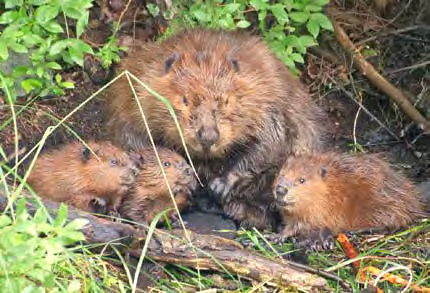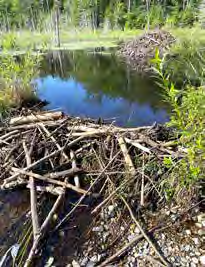No Beavers Would Be a Dam Shame!
Published Sep 1st, 2023 by Lynnwood Andrews
 Beaver family in Hubbardton, VT.
Beaver family in Hubbardton, VT.
Beavers cut down trees to build dams which create ponds and wetlands and open gaps in the forest canopy, benefitting a wide range of plants and animals. Allowing beavers to build and maintain lodges can be one of the most important things you can do to support local wildlife, increase biodiversity, improve forest health, and mitigate flooding.
Beaver ponds provide habitats for amphibians, birds, macroinvertebrates and insects, and woodland mammals. In early spring, bears rely on the green plants that emerge in beaver ponds when little else is up. Bats forage on insects growing in the ponds. Snags created in the wetlands provide nesting sites for wood ducks, songbirds, and herons. Ponds are regularly used by moose, mink, otters, muskrats, and waterfowl and are inhabited by fish, such as brook trout. A study in Maine found that otter populations were significantly correlated with beaver ponds and meadows.
Beavers are a keystone species because they create wetlands, one of the most biologically diverse kinds of habitats. Beaver activity is cyclic. Their dams and resulting ponds usually last for 10-20 years according to the amount of food available. The beavers move on when the food source is depleted. The abandoned dam eventually gives way, and another kind of wetland, a wet or “beaver meadow”, results. Over time, pioneer species such as willow and aspen overtake the meadow, followed by canopy species.
Recent research in the Adirondacks suggests a second vital ecological function: the creation of gaps in the forest canopy through felling trees and repeated culling of saplings 1-2 inches in diameter which maintains the development of early succession plants. These patches promote forest regeneration as well as provide areas of significantly increased biodiversity and wildlife habitat. Because forests in New England today generally started growing at the same time following the massive deforestation of the eighteenth and nineteenth centuries, the forests lack the range of tree sizes and diversity they need for optimal health. Beavers are one important source of forest disturbance along with fire and wind damage fostering forest regeneration.
Beaver ponds and meadows control water flow through the landscape. The ponds and meadows slow down the speed of water, lessening flood damage downstream. In addition, they store water allowing for replenishment of groundwater and aquifers.
 The beaver lodge and dam in Marshfield, VT.
The beaver lodge and dam in Marshfield, VT.
The Vermont Fish and Wildlife Department actively encourages the preservation of beavers through the Beaver Wetlands Conservation Project. They have a program to assist landowners when they experience conflicts with beavers to find solutions that allow the beavers to stay in place if at all possible. Specialized baffles and culverts can often make it possible for beavers to stay in place and control local flooding within acceptable limits. If the beavers need to be removed, the use of licensed trappers is encouraged. These trappers use humane traps and see that the beavers’ meat and pelts are used rather than thrown away. They also work in conjunction with wildlife biologists monitoring the size and health of Vermont’s beaver population.
The Vermont Department of Fish and Wildlife document detailing best management practices for human-beaver conflicts is available here.
Please monitor your land for beaver activity. In Vermont, no one may trap animals on private land without landowner permission. Further, no one may erect stands or blinds, park, drive, camp, or direct others to hunt or trap on private land without landowner permission. Help preserve and protect the beaver.
Originally published in Fall 2023 Norwich Times